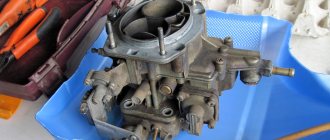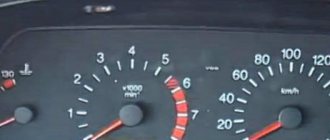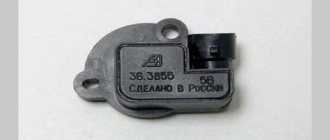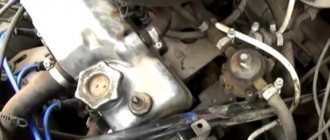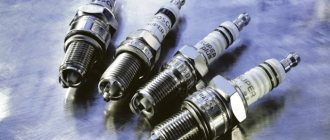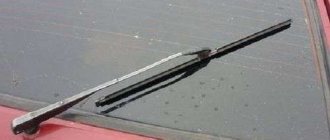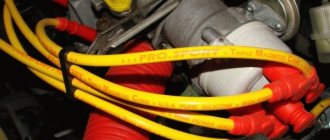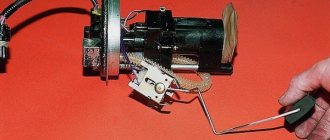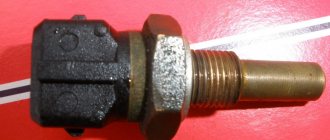The best
look at the fuel pressure in the rail, if there is a return line, see if gasoline is flowing from it, if it doesn’t, then there is no fuel pressure in the rail,
look at the main relay, the fuel pump relay, the fuses, right the caps with it from them and look, maybe the main thing clicks for you and immediately hangs up or doesn't turn on at all,
see if the immobilizer is sewn into the firmware, flash the firmware from the ECU to the table and look, or replace it with another ECU, look for errors with a scanner,
look at the readings of the mass air flow sensor and the IAC (the latter can be checked by slightly opening the throttle valve)
There is probably not a single owner of a domestic car who has never found himself in a situation in which the engine of his car refused to start. A similar problem is familiar to drivers of foreign cars, but our cars suffer from this “disease” much more often.
It often happens that the car starts and immediately stalls. There can be many reasons for this. We will talk about them in this article using the example of a VAZ-2109 car with carburetor and injection engines.
First, let's look at the most common problems.
- Gasoline (diesel fuel) has run out. No matter how paradoxical it may sound, drivers often forget to monitor the level of fuel in the tank.
- On diesel engines (especially in winter), the reason that the car started and stalled almost immediately could be frozen fuel (but as a rule, diesel VAZs are very rare).
- The quality of gasoline at gas stations is often appalling, so if you fill your car with low-quality fuel, you may encounter the problem of a stalled engine. If there is only a little bad gasoline, you can dilute it with good gasoline. But if the tank is full, then it’s better to drain the surrogate out of harm’s way.
- Worn wires and old (faulty) spark plugs are also quite often the cause.
- Engine compression, or rather its absence, can provoke a situation in which the engine stalls barely having time to “catch up”. But this is already a very serious breakdown, the appearance of which is accompanied by a host of other symptoms, which are simply impossible not to notice during the operation of the car.
An interesting article about biofuel produced from ordinary sawdust, read more here.
Checking the presence and condition of the spark
Determining whether voltage is being supplied to the spark plugs is not difficult. It is enough to unscrew one of them, connect the central electrode to the corresponding high-voltage wire, ensure that its “skirt” is in contact with the “ground” of the car, turn on the ignition and start the starter. If a stable blue or white-blue spark is observed on the electrodes of the spark plug, everything is in order with ignition. It wouldn’t hurt, of course, to check all the spark plugs in the same way. The fact is that very often the reason that a car starts and immediately stalls is a malfunction of one or more spark plugs.
If there is a spark on all spark plugs, pay attention to its color and size. If it is yellow or red in color, and its size is disproportionately small compared to the interelectrode gap, this may also be the reason why your car starts and immediately stalls.
Finding the faulty component
So, what should you do if the engine starts easily, but immediately slows down and stops? First of all, check for carbon deposits on the spark plugs. If some of them are covered with a layer of carbon, the engine a priori cannot operate normally. It starts initially due to the movement of the starter, but soon thereafter slows down as several cylinders are physically unable to support the full load from the crankshaft. The carburetor, by the way, can also fail due to such a problem.
So what is the cause of engine failure? If the car starts, then at least the spark is fine. That is, the electrics work as expected. It wouldn’t hurt to turn your heads and try to find those candles covered with a layer of soot. They can be cleaned by burning them on a gas stove and wiping them with alcohol (this can only be done on cold contacts).
The injector itself may also become clogged. In this case, the fuel supply to the combustion chamber simply does not work. You need to do the following:
- Check if the motor operates normally at temperatures above 80°C.
- remove the blocks and check the shock absorbers;
- check the operation of the sensors;
Of course, the fuel pump itself may fail. When the engine starts, it automatically turns into an injector due to the starter, so there is draft from the generator. If any of these components fail, the car will simply collapse. Again, this is the remaining amount of fuel in the cylinders. If the engine stops immediately, and along with it the starter works unevenly, then most likely the problem is in it or in the ignition switch.
You should try replacing it with a known one and check the engine operation again. In extreme cases, the contacts are simply tightened.
We diagnose high-voltage wires
If you determine that everything is in order with the spark plugs, and the VAZ-2109 starts and immediately stalls, as before, it is worth checking the high-voltage wires. Due to the constant loads created by high voltage, they also often fail. A wire malfunction is a violation of the integrity of the current-carrying core or insulation. In the first case, electricity does not flow to the spark plug at all, as a result of which the spark disappears. If there is damage to the insulation, a breakdown occurs between the conductive core and the “ground” of the car, that is, part of the electricity simply goes away. Because of this, the spark loses power, and often the ability to ignite the fuel mixture.
High-voltage wires are checked in the same way as spark plugs. Additionally, the resistance value of the conductor is measured. Depending on the brand and model of wires, it can range from 0.4 to 0.9 kOhm.
The engine stops while running - reasons
1. Poor quality fuel is the first thing that comes to mind for most of us, and this is where we need to start looking for the reason for the engine stopping. You will be lucky if this happens immediately after refueling, in which case it is safe to say that the problem is in the fuel. Treated by draining the fuel and.
2. Candles. As a rule, suspicion falls on them most often, of course, after bad fuel. Everything is simple here - unscrew the spark plugs and, if necessary, check their condition.
3. Fuel filter. A clogged filter can cut off the fuel supply, causing gas and stalling the engine. It is enough to eliminate the malfunction.
4. Air filter. Everything is the same as with fuel, if it is clogged, air does not flow, then again the air-fuel mixture comes out enriched and the spark plugs are simply flooded. In addition, due to a lack of air, the engine will throttle, that is, the power will decrease and the process of combustion of the mixture in the cylinders will not be able to occur, and over time the engine will stall. To eliminate this problem, it is enough to replace the air filter.
5. A faulty fuel pump is the second “suspect”. If your fuel pump fails, your car will behave like this: it will stall while driving or the engine will not start at all. The problem can be solved by checking the pump, repairing it or.
6. Battery. Oxidated battery terminals or poor connections can cause the engine to stall. Check the terminals and clean or replace the battery if necessary.
7. If the engine stops moving and will no longer start, the alternator may also be the cause. A failed generator does not charge; as a result, the vehicle’s on-board network is powered exclusively by the battery and, as we know, will not last long. As a result, you, unaware that the car is running on battery power, continue to drive until it is completely discharged. Treated - a.
6. In advanced cars, the reasons may also be in electronics and various sensors. If you are not good at this and all of the above components and parts are normal, then it is better to contact specialists, otherwise you can replace the nonsense car floor using the “dialing…
Injection engine power system sensors
Often it is a faulty mass air flow sensor that causes the injection “nine” to start and immediately stall. This sensor determines the amount of air flowing through the air duct into the intake manifold. Based on its data, the electronic control unit regulates the concentration of the fuel mixture. The slightest malfunction of the mass air flow sensor leads to its incorrect formation. As a result, we have an increase in fuel consumption, floating idle speed, and problems with starting the engine.
Well, how can we not mention the idle speed regulator (sensor). It is he who receives a signal from the electronic control unit about the required amount of air for the combustible mixture and mechanically increases or decreases its volume. The regulator is directly involved in starting the engine and its operation during the warm-up phase in idle mode. So if your car starts and immediately stalls, do not forget to check the IAC.
What to do if the problem is in the ECU?
The engine may not work properly if the on-board computer is not working properly. At VAZ, it is he who is responsible for the timely supply of fuel, synchronizing the operation of the injector nozzle and spark plugs. When the engine stops immediately, this indicates a discrepancy between the timing of fuel delivery and the ignition of the fuel mixture.
As a rule, it is useful to change the firmware or restore it to the factory state. Although sometimes it may simply be necessary to adjust the fuel cycle, as well as the saturation of the mixture. As a last resort, on a VAZ 2110 (or later model) you will have to replace the entire ECU unit or turn it off by starting the engine only by a mechanic.
It should be noted that not only the ECU itself is responsible for the operation of the engine, but also a number of sensors that regulate the pressure in the injector, the saturation of the mixture and the ignition timing.
That is, you need to check their work. However, if a fault is detected in any of them, a Check Engine signal should be sent to the dashboard. This, for example, happens when starting a VAZ 2110. This does not happen only if the ECU simply does not receive signals from the sensors. It is worth noting that the model 2107 does not have a computer installed by default, but without it the injector does not work.
Similar problems arise when a carburetor is synthetically modified for an injector, but the on-board computer remains the same. They simply change the firmware, connect new modules, but you need to understand that it was not initially designed for such work. Therefore, if the carburetor is modified, the ECU must be replaced with a compatible model along with it. Fortunately, VAZ took care of their release.
So, if the injector immediately starts and freezes, the main reasons for this malfunction are malfunctions of the electronics (including the computer), improper operation of the fuel system, or problems with gasoline filtration. Determining the root cause is not difficult. As a last resort, you can always contact the service center. But it is worth remembering that any changes in the operation of the on-board computer can only be made with a fully functional engine.
In this article we will dwell in more detail on the situation when a carburetor engine of a car (VAZ 2108, 2109, 21099, 2105, 2107 and their modifications) starts and stops due to a carburetor malfunction. Malfunctions of carburetors 2105, 2107 Ozono, 2108, 21081, 21083 Solexi and their modifications will be considered. Symptoms of malfunction - The engine starts, runs for a few seconds and stops, repeated starts are ineffective. – The engine starts with difficulty, stops after a short period of operation, then starts and starts after a restart.
– The engine starts and stops immediately, starts again and stops again, and so on several times, but then it starts running again.
Causes of malfunction
There is no fuel in the float bowl
Prime it using the manual prime lever on the fuel pump.
Starter diaphragm damaged or out of adjustment
Remove the starter housing and replace the diaphragm with a new one. Adjust the starter.
starters for carburetors 2108, 21081.21083 Solex, 2105, 2107 Ozone
Fuel and air jets, emulsion wells and pipes of the main metering system are clogged
you need to remove the carburetor cover, unscrew the jets, remove the hoses, rinse and clean them, clean the wells, blow everything with compressed air and reassemble. The picture shows that it is worth cleaning the carburetor 2105, 2107 Ozone.
Unscrew the jets on the Solex carburetor and remove them along with the emulsion tubes. At the bottom of open wells there are streams of fuel. We turn them with a long thin slotted screwdriver. Clean, rinse with acetone and blow with compressed air.
fuel and air jets, emulsion tubes and emulsion wells Carburetors GDS 2108, 21081, 21083 Solex, 2105, 2107 Ozone
Fuel and air jets and idle system channels are clogged
Unscrew the injectors, rinse and clean them, and blow them with compressed air.
air and fuel jets for CXX 2108 Solex and 2105, 2107 Ozone carburetors
The fuel level in the float chamber is broken
The fuel mixture is very lean or very rich due to incorrect adjustment.
approximate fuel level in carburetor tanks 2108, 21081, 21083 Solex, 2105, 2107 Ozone
Articles on the site about adjusting the fuel level:
The carburetor choke gear is not adjustable (“intake”)
Owners of VAZ 2107, 2110, 2112, 2114 and other cars may encounter a problem - the car immediately starts and crashes. The engine starts, but after a few seconds the speed drops and the engine stops. Let's look at the possible causes of startup failure and how to eliminate them.
IAC check
To check the idle air control, we use a multimeter turned on in ohmmeter mode. Before starting diagnostics, the IAC must be disconnected from the on-board circuit. First of all, we measure the resistance between terminals A and B, after C and D. It should be within 53 Ohms. Next, we measure the resistance between A and C, B and D. Here it should tend to infinity. If the test results differ from the given values, the regulator is faulty, and, most likely, it is to blame for the fact that your car starts and immediately stalls. The reason for the failure of the IAC may be either a break in one of the windings, or wear of the cone needle guides. In any case, it is better to replace it.
If the car stalls
Sudden engine stops not only create discomfort while driving, but also pose a threat to the safety of the driver and passengers. There are several reasons.
Minimum kiosks:
- Malfunction of the throttle position sensor.
- failure of the idle speed sensor;
- throttle sensor malfunction;
Shops on the go:
- motor overheating.
- fuel pump malfunction;
- clogged carburetor jets;
- interruption of fuel or air supply due to a dirty filter;
It is best to start diagnosing a car whose engine stalls in the most unexpected places by checking the idle speed sensor.
It’s easy to check its functionality. Disassemble the device without removing the contacts or connecting them after disassembly. Take the device in your hands, place your finger on the needle of the cone and ask a friend to turn on the motor. If you feel jerking, put the device back. The idle speed sensor is OK.
If the throttle sensor fails, the car will not only stop, but will not start because the ECU will command maximum fuel flow, the spark plugs will fill, and the engine will shut down.
If you are driving a VAZ car and there is a problem with the throttle sensor, it is easier not to worry and contact the nearest service center, but if you get to the garage, you can use the following instructions:
- Remove the sensor.
- Drill the plastic cover with a 2mm drill in a circle.
- Pull out the plastic cover of the upper contact block.
- On the lower deck, clean the tracks with WD-40 or denatured alcohol.
- Same with the top cover contact assembly, but don't bend them, they will eat the tracks prematurely.
- Reassemble in reverse order.
- Coat the contour with any plastic glue.
Possible carburetor malfunctions
Now let's talk about the problems with starting carburetor engines of "nines". There are no sensors here that affect the operation of the power system, but this does not mean that there are fewer problems with them. If you are confident that the ignition system is working, but your car starts and immediately stalls, the carburetor is the reason. Or rather, one of its working elements is responsible for the engine idling.
It is recommended to start checking with the idle air solenoid valve. This device more often than others causes the VAZ-2109 to start and immediately stall. It does not matter which carburetor is installed on the engine.
The simplest method for diagnosing the valve is to disconnect and connect the device to the power wire with the ignition on. Clicks that occur when the positive wire is connected to the corresponding terminal indicate that the electromagnet is working properly. If the valve does not respond to the supply of electricity, you can safely throw it away. Naturally, installing a new one in its place.
After unscrewing the solenoid valve, check the condition of the idle fuel jet at the same time. If necessary, blow out and flush it with carburetor cleaning fluid. A clogged idle jet also negatively affects engine operation without load.
The leakage of excess air into the system also leads to problems with starting the power unit. As a result, the fuel mixture becomes leaner, and the engine begins to operate intermittently, losing speed and power. Check the tightness of the system at the attachment points of the vacuum tubes going to the distributor and brake booster, as well as the seat of the idle air valve.
Accelerator pump failure
What causes problems with the accelerator pump:
- Incorrect spray dosage or channel blocked by debris.
- Worn (torn) diaphragm.
- The pump drive is incorrectly selected.
Factory-made sprayers have two strokes directed into the chambers. Most experts are sure that the second “spout” in this system is superfluous, so you can install a sprayer with one stroke, as, for example, on the Niva.
You need to check the presence of the atomization process by removing the carburetor and unscrewing the top cover. In this case, fuel must be filled into the float chamber. The throttle valve opens, and two jets pass through the lower part of the housing without touching it - this is a sign of serviceability.
The car starts in cold weather and immediately stalls
Low temperature can affect the stability of the engine only if the fuel pump is faulty. Are you trying to start the engine in severe frost, it starts, but after a few seconds it stalls? Try pumping fuel using the pump lever. If the situation has changed, look for a problem in the pusher. In addition to the fact that its sealing gaskets may be worn out, which, moreover, become harder in severe frost, it itself may become covered with frost. All this makes it difficult for him to move. As a result, fuel enters the carburetor in a smaller volume, which, again, leads to a leaner fuel mixture.
Problems with Solex carburetors
In addition to all of the above, engine speed drops if the fuel level in the carburetor (float chamber) is incorrectly adjusted. As a result, there is either not enough gasoline in the fuel mixture or too much of it. When adjusting the VAZ 2107 carburetor, it does not need to be disconnected from the engine.
Follow these steps:
- remove the air filter housing by unscrewing all fasteners;
- remove the carburetor cover;
- check the position of the floats. To do this, separate and bring them together to achieve the correct location.
It is necessary to achieve such a position of the floats so that they move freely without clinging to the walls of the chamber in which they are located. It will not be superfluous to measure the distance from the protrusions on the floats to the paper gasket. The distance should be within 0.75–1.25 mm. Use a feeler gauge to measure.
What to do if it is far from normal? In this case, you need to adjust the height of each of the floats.
As we have seen, there are many reasons why the engine stalls. To start the engine correctly, you need to check and eliminate all the above faults. Afterwards, if the problem is not resolved, you will have to contact specialists.
Didn't find the information you are looking for? on our forum.
Reasons for changes in engine operation
What to do if the VAZ injector starts and stalls at idle? This problem most of all concerns old cars, since with age various contaminants accumulate in the fuel system and in the throttle assembly, as well as sensors and mechanisms wear out - all this will inevitably lead to changes in engine operation.
We will describe in order all the reasons that lead to this problem.
- The first thing to check is the mass air flow sensor (MAF). The sensor's sensing element becomes dirty and wears out with age, which is why its resting voltage increases and its reaction time to changes in air flow increases. If the quiescent voltage exceeds 1.035V, you should think about replacing the sensor, because it will no longer be able to give inflated readings on air flow. The electronic control unit will supply more fuel and the mixture will be over-rich - and this will have a very bad effect on all engine operating modes, as well as on idle stability.
- The idle air control (IAC) can also affect the stability of the engine. Rod jamming is the most typical malfunction in it. In addition, with age, natural wear and tear occurs on the components of the regulator, and this leads to problems with movement. The usual service life is 100-150 thousand km. Only with the help of special equipment can you check the IAC, and it is better to replace it with a new one immediately if a malfunction is suspected.
- Very often it is enough to simply clean the throttle assembly from dirt. It's easy to do it yourself. These are the most basic cases that you need to pay attention to. Atypical situations will follow.
- Sometimes the problem is a leaking intake manifold. You need to check the gaskets, vacuum hoses, injector O-rings, and the vacuum brake booster and manifold plugs. The easiest way to find air leaks is with a smoke generator.
- Pay attention to fuel pressure.
- You also need to check the ignition system and spark plugs in particular.
In conclusion, it should be noted that without special equipment, a complete check of the system is impossible. Only with its help can the fault be accurately identified.
Effect of air leaks in the fuel system
Unstable operation of the internal combustion engine, failures during acceleration of the car can also occur due to air leaks in the fuel system (TS), because as a result of the appearance of excess air mass, the proportion of the mixture necessary for the complete combustion of gasoline in the cylinders is disrupted.
Air suction can occur:
- between the top cover and the main body of the carburetor due to metal deformation;
- due to a loose fit of the lower platform of the HRSG to the intake manifold;
- as a result of a rupture of the hose or its poor connection with the fittings of the vacuum brake booster (VUT);
- due to a malfunction of the vacuum booster itself.
